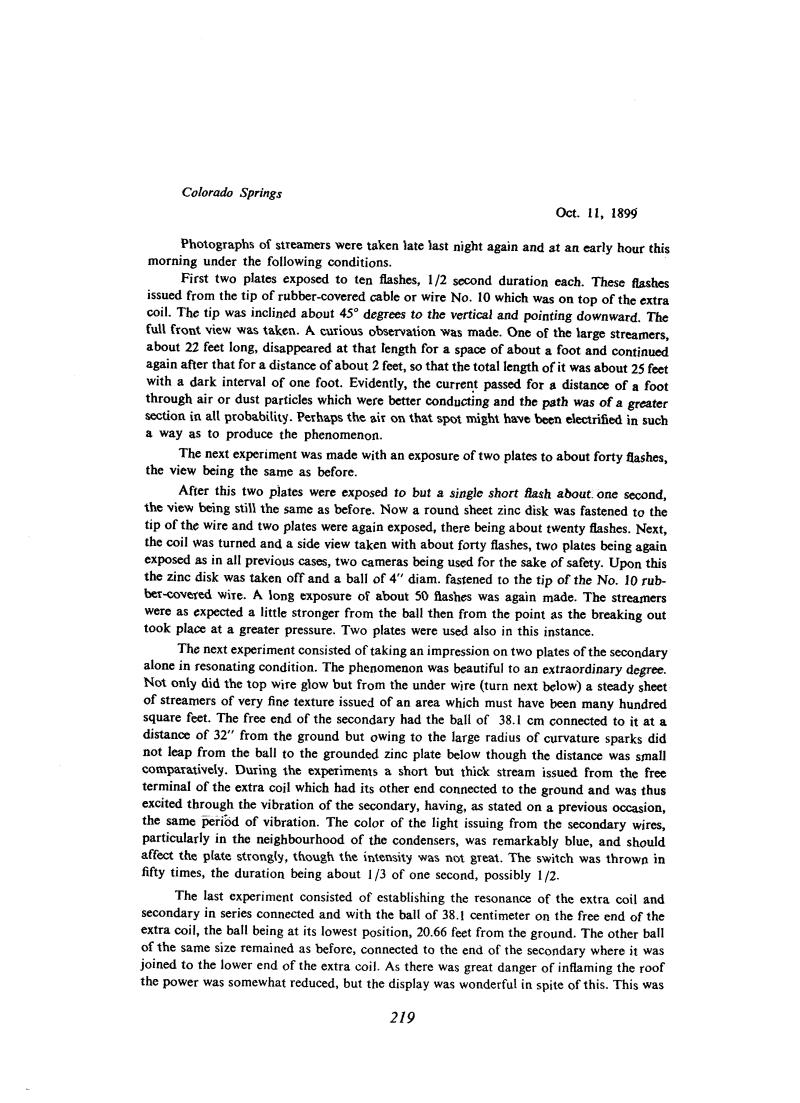
Nikola Tesla Books
Colorado Springs
Oct. 11, 1899
Photographs of streamers were taken late last night again and at an early hour this morning under the following conditions.
First two plates exposed to ten flashes, 1/2 second duration each. These flashes issued from the tip of rubber-covered cable or wire No. 10 which was on top of the extra coil. The tip was inclined about 45° degrees to the vertical and pointing downward. The full front view was taken. A curious observation was made. One of the large streamers, about 22 feet long, disappeared at that length for a space of about a foot and continued again after that for a distance of about 2 feet, so that the total length of it was about 25 feet with a dark interval of one foot. Evidently, the current passed for a distance of a foot through air or dust particles which were better conducting and the path was of a greater section in all probability. Perhaps the air on that spot might have been electrified in such a way as to produce the phenomenon.
The next experiment was made with an exposure of two plates to about forty flashes, the view being the same as before.
After this two plates were exposed to but a single short flash about one second, the view being still the same as before. Now a round sheet zinc disk was fastened to the tip of the wire and two plates were again exposed, there being about twenty flashes. Next, the coil was turned and a side view taken with about forty flashes, two plates being again exposed as in all previous cases, two cameras being used for the sake of safety. Upon this the zinc disk was taken off and a ball of 4" diam. fastened to the tip of the No. 10 rubber-covered wire. A long exposure of about 50 flashes was again made. The streamers were as expected a little stronger from the ball then from the point as the breaking out took place at a greater pressure. Two plates were used also in this instance.
The next experiment consisted of taking an impression on two plates of the secondary alone in resonating condition. The phenomenon was beautiful to an extraordinary degree. Not only did the top wire glow but from the under wire (turn next below) a steady sheet of streamers of very fine texture issued of an area which must have been many hundred square feet. The free end of the secondary had the ball of 38.1 cm connected to it at a distance of 32" from the ground but owing to the large radius of curvature sparks did not leap from the ball to the grounded zinc plate below though the distance was small comparatively. During the experiments a short but thick stream issued from the free terminal of the extra coil which had its other end connected to the ground and was thus excited through the vibration of the secondary, having, as stated on a previous occasion, the same period of vibration. The color of the light issuing from the secondary wires, particularly in the neighbourhood of the condensers, was remarkably blue, and should affect the plate strongly, though the intensity was not great. The switch was thrown in fifty times, the duration being about 1/3 of one second, possibly 1/2.
The last experiment consisted of establishing the resonance of the extra coil and secondary in series connected and with the ball of 38.1 centimeter on the free end of the extra coil, the ball being at its lowest position, 20.66 feet from the ground. The other ball of the same size remained as before, connected to the end of the secondary where it was joined to the lower end of the extra coil. As there was great danger of inflaming the roof the power was somewhat reduced, but the display was wonderful in spite of this. This was
219
October 11
Tesla obviously did not sleep much the previous night since he was photographing the oscillator in operation both late at night and early in the morning. The Nikola Tesla Museum in Belgrade possesses several photographs which date from this period, but they are too faded to be worth showing. One of the better preserved photos is shown on p. 221.
October 11
Last night Tesla obviously did not sleep much, because he was photographing the oscillator in operation. The photographs were made late in the evening and early in the morning. In the archives of Nikola Tesla museum, several photographs were found which originate from this period but they faded so much that it was not possible to show them. One photograph which is better than others could be seen on Page 221.

